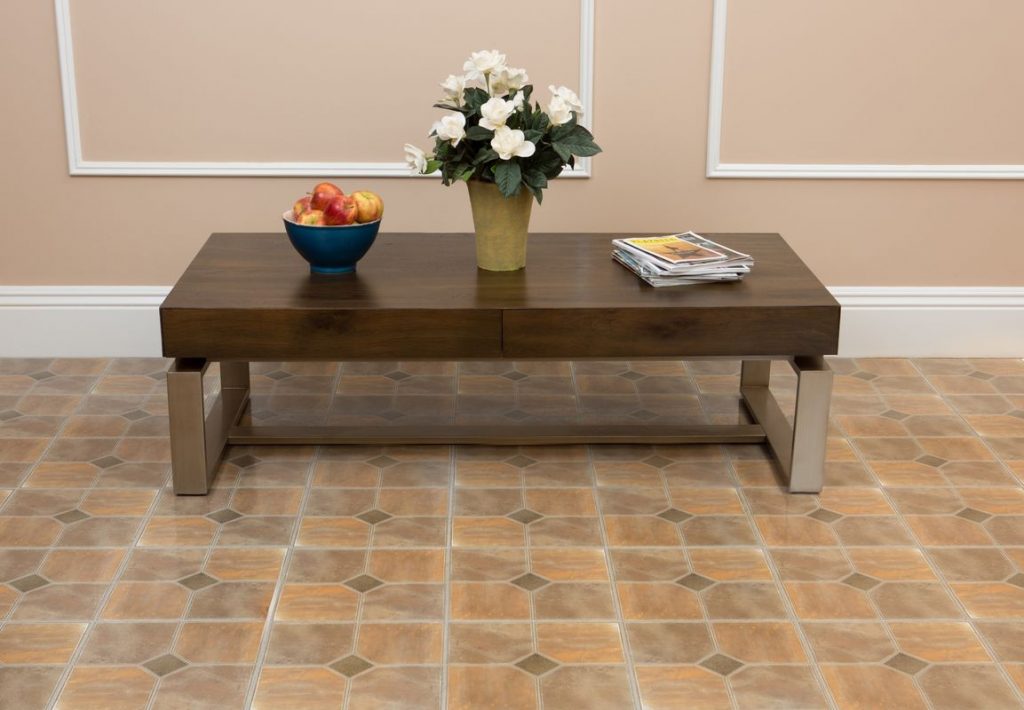How to Install Glue Down Vinyl Tile Flooring

So you’ve finally picked out a style of vinyl tile flooring that best fits your room. Now comes the tricky part. Whether you’ve installed your own flooring dozens of times or you’re a straight-up rookie, laying a new floor can sometimes prove to be trickier than expected. Luckily, one of the advantages of going with glue-down vinyl tile flooring is that it’s an accessible flooring style for DIY repair homeowners. If you’re about to finally have the surface of your dreams, here’s what you need to know when it comes to installing glue down vinyl tile flooring yourself:
Know what you need when installing glue down vinyl tile flooring
Before you even think about laying the tile down, you’ll need to make sure you’re entirely prepared for this project. Preparing well and following the right installaion procedure minimizes waste, lowering the cost to install vinyl flooring. For starters, that means accurately measuring the length and width of your floor to find it’s total area. After you’ve calculated the area, you’ll now need to figure out how many boxes of tile you’ll need. To do this, simply take the square footage that accounts for the entire surface and divide it by how many square feet your box of vinyl tile has in it. For instance, if your floor’s square area is 100 feet, and each box of tile equates to 10 square feet, you’ll need 10 cartons of tile. Of course, it’s always a good idea to have a little extra on hand to be better safe than sorry. Often, purchasing 10-15% extra for waste is recommended.

Know what you are installing on top of
One of the great aspects of installing vinyl tile flooring is that you can simply lay it over existing floor surfaces. However, it’s important to determine whether your previous floor is in good enough condition to have new vinyl tile covered over it. If you’re unsure, contact a professional installer so you can get an appropriate assessment of whether or not your old floor is suitable enough to have the new vinyl tile placed over it. You may encounter a scenario in which your old floor is simply too difficult to repair or replace, in which case you’ll need to rip it up and properly prepare your substrate before you install the vinyl tile. Plywood is a commonly used substrate in this instance.
Divide your floor
After you’ve decided whether you’re covering an existing floor or you’re starting from scratch, you’ll need to divide the floor up and indicate the room’s center point. Essentially you’ll want to create a grid, so lay down some thin chalk line to mark the floor’s quadrants, starting from the center. This will help you better visualize where the tiles will be placed.
“An essential rule to installing vinyl tile flooring is to begin at the center of your room, rather than at one of the corners.”Begin in the center
An essential rule to installing vinyl tile flooring is to begin at the center of your room, rather than at one of the corners. When you’re about to begin installing the tile, you’ll need to spread an adhesive using a trowel onto the substrate, so the vinyl squares will remain fully bonded. Make sure you’re gently pressing the tiles onto the floor, and once you’ve completed one row, start on the next.
It’s highly likely that your row of tiles won’t perfectly fit into your space, so make sure you measure the remaining length of tile needed to complete a row, then cut another piece of tile to fit the adjacent space. For a smart finish, use the right tool when cutting vinyl flooring. A miter saw is best, but, in the right hands, a utility knife can also work well.
After you’ve laid the tile
Once you have the tile laid down, you’re approaching the home stretch. The best environmental conditions for installation requires keeping the temperature of the subfloor between 65°F to 85°F (18°C to 29°C) for 48 hours prior to, during and 48 hours after installation. Make sure your tiles fit tightly against each other and if you notice any of the gel beginning to ooze out of the edges, quickly wipe it up with a damp rag. Remember, flooring must be installed within two hours of applying the adhesive. You also won’t want to wash your new floor for at least a week because you want to give the adhesive time to settle. Apply pressure to each tile so they bond to the substrate by using a vinyl floor roller. Make sure you don’t walk on it right away, give it at least a few hours to bond. Soon enough, you can stand back and admire you’re brand new vinyl tile floor!
As always, when installing flooring, follow the manufacturer’s recommendations specific to your product. Contact a professional installer if you have any further questions.
Is a DIY vinyl tile installation something you’d like to pursue?Click here to take a look at our stunning online selection of luxury vinyl tile flooring. Discover the right look for your space!



Emily
Can I glue vinyl tiles to cement? And are they durable to sustain water? Will adhesive stick even if it gets wet? I occasionally have water in my basement but I’m looking for flooring that I won’t have to pull up each time.
Stefanie farris
Can we wait until the day after installation to roll the vinal? We didn’t finish tonight and cant get a roller until morning
Kevin
Do I need to use ac ply underpayment for glue down vinyl plank or can it be applied to the 3/4 ply subfloor?
BuildDirect Product Expert Team
Hi Kevin,
Thank you for your inquiry! You can glue the vinyl plank directly to the 3/4″ plywood sub floor. Please let us know if you have any other questions!
sean gregg
Do I need to put down Lauan before installing?
BuildDirect Product Expert Team
Hi Sean,
Thank you for getting in touch! Your subfloor doesn’t need to be Lauan specifically. Plywood or concrete are fine as well. If you do install over concrete, you will need to put down a vapor barrier to protect the vinyl tile from the moisture that concrete sweats. Please let us know if you have any other questions!
Don
Can you use a vinyl plank floor and glue down in an RV. i live in a Northern climate so for part of the year the unit would have no heat
BuildDirect Product Expert Team
Hi Don,
Technically you can but we don’t recommend it. Vinyl planks will expand and contract based on the temperature in the area and if you have the unit without temperature control in the Winter the floor could come apart. Please let us know if you have any other questions!
Billy Dyson
What size trowel gap should I use to obtain a thin layer of adhesive, and do I have to trowel in two directions …??
Should I let the adhesive flash over before laying the plank, or can I lay it immediately…???
BuildDirect Product Expert Team
Hi Billy,
Thank you for your questions! Unfortunately I’m unable to give a straight answer on both of those questions because the answers depend on the specific product and adhesive you are using as well as your type of subfloor. I highly suggest thoroughly going through the installation instructions for the vinyl planks as well as the adhesive. The trowel size and amount of adhesive will be dependent on whether your subfloor is porous or not and it should be specified in the installation instructions. If you have any more questions please feel free to give us a call at 1-877-631-2845 and a product expert will be able to help out!
BuildDirect Product Expert Team
Monica,
Thank you for the question. We carry two products by DriTac that are suitable for use with Luxury Vinyl Flooring. You can find their Premium Adhesive and the more eco-friendly Premium Green Adhesive through the link here.
Monica Rollins
what type of glue do i use for a glue down vinyl plank flooring?